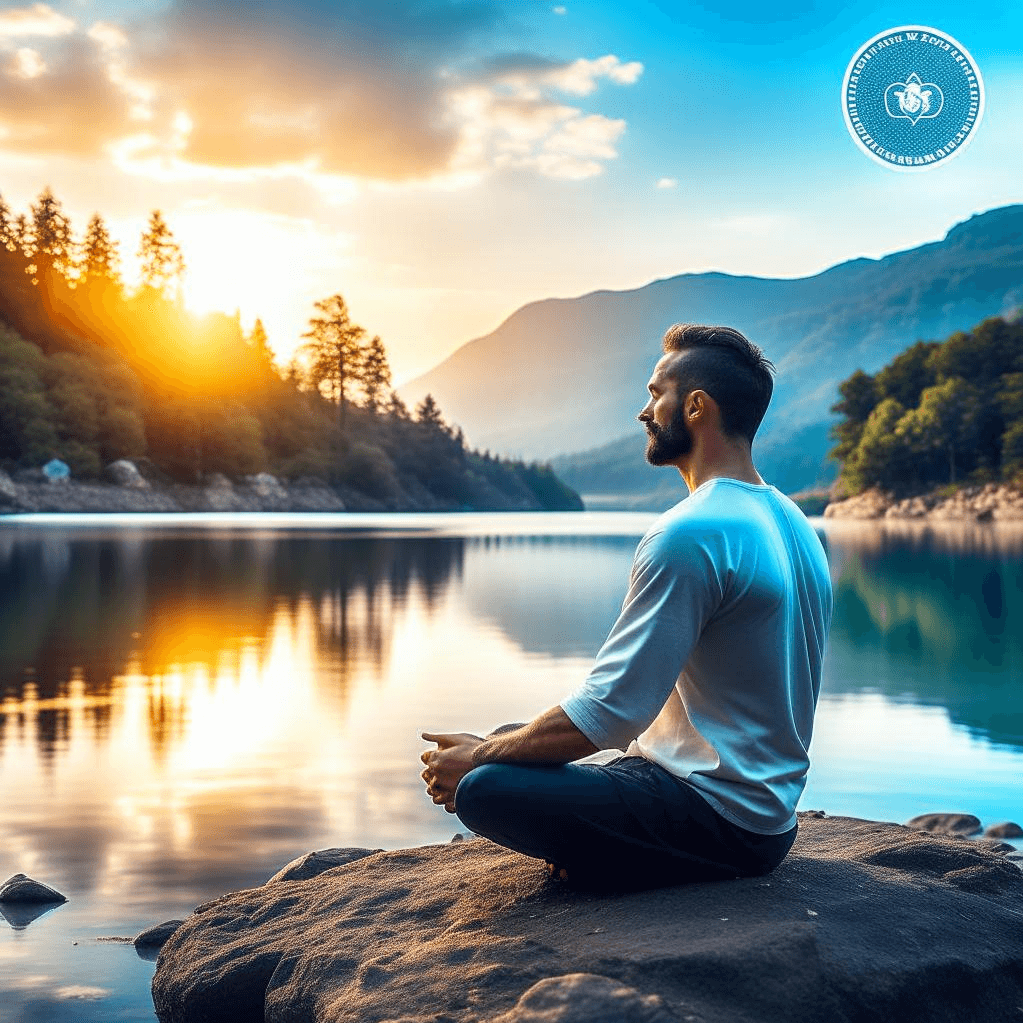In today’s fast-paced world, finding inner peace has become more important than ever. Achieving a calm mind can have a profound impact on our overall well-being, allowing us to navigate life’s challenges with clarity and resilience. One powerful tool to cultivate inner peace is meditation. This ancient practice has been embraced by cultures around the world for centuries. By dedicating just a few minutes each day to meditation, we can tap into a deep sense of tranquility and harmony within ourselves. In this article, we will explore a simple guide to meditation, providing you with the tools and techniques to find inner peace and create a calm mind. So, let’s embark on this journey together and discover the transformative power of meditation.
Contents
I. Understanding Meditation
II. Preparing for Meditation
III. Getting Started with Meditation
IV. Practicing Mindfulness Meditation
V. Exploring Transcendental Meditation
VI. Overcoming Challenges
VII. Integrating Meditation into Daily Life
VIII. Conclusion
I. Understanding Meditation

Meditation is like a magic potion for your mind. It’s a special practice that helps you find peace and calmness within yourself. When you meditate, you enter a state of deep relaxation and focus, which can have amazing benefits for your mental and emotional well-being.
There are different types of meditation, each with its own special powers. One type is called mindfulness meditation. It’s all about paying attention to the present moment and being aware of your thoughts and feelings without judgment. It helps you become more grounded and less stressed.
Another type of meditation is called transcendental meditation. It’s like taking a journey to another dimension of your mind. You use a secret mantra, which is like a special word or sound, to help you reach a state of deep relaxation and clarity. It’s like unlocking the hidden powers of your mind.
When you meditate, it’s important to create a peaceful and comfortable environment. Find a quiet spot where you won’t be disturbed, and make sure you’re sitting or lying down in a comfortable position. You can even light some candles or play soothing music to create a relaxing atmosphere.
To start meditating, take a few deep breaths to relax your body and mind. Then, focus your attention on your breath or a specific object or thought. Try to let go of any distractions and just be in the present moment. If your mind starts to wander, gently bring it back to your chosen focus.
Sometimes, it can be challenging to stay focused during meditation. Thoughts may pop up or you might feel restless. But don’t worry, it’s normal! Just gently bring your attention back to your focus and keep going. With practice, it will become easier to stay in a state of calmness and concentration.
Meditation is not just something you do during a specific time or place. It’s a way of life. You can bring the benefits of meditation into your everyday activities. By being more mindful and present, you can find peace and calmness in even the simplest of tasks, like washing dishes or walking in nature.
So, why not give meditation a try? It’s like a superpower for your mind, helping you find inner peace and a calm mind. Start your meditation journey today and unlock the incredible benefits it can bring to your life.
II. Preparing for Meditation

Before you start your meditation journey, it’s important to create a peaceful and comfortable environment. Find a quiet and cozy spot where you can relax without any disturbances. You could even light some scented candles or play soothing music to enhance the calming atmosphere.
Choose a time that works best for you. It could be early in the morning when the world is still asleep, or in the evening when you want to unwind after a long day. The key is to find a time when you can fully devote yourself to the practice without any distractions.
When it comes to posture, find a position that feels comfortable for you. You can sit cross-legged on a cushion, or even lie down if that’s more relaxing. The important thing is to keep your spine straight to allow for proper energy flow.
Now, let’s take a moment to imagine that as you prepare for meditation, you can actually transport yourself to a magical place. Picture yourself in a serene garden, surrounded by beautiful flowers and gentle flowing water. This imaginary setting can help create a sense of tranquility and peace in your mind.
Remember, meditation is all about finding inner peace and calming the mind. So, take a deep breath and let go of any worries or stress. Imagine that with each breath, you are inhaling positive energy and exhaling any negativity or tension.
In this mystical garden, you can also imagine that there are fairies or gentle beings who are there to guide and support you in your meditation practice. They can provide you with a sense of comfort and encouragement as you embark on this journey of self-discovery.
As you begin your meditation, focus your attention on your breath. Feel the sensation of the air entering and leaving your body. If thoughts or distractions arise, imagine that these magical beings gently sweep them away, allowing you to stay fully present in the moment.
Now, let’s imagine that in this enchanted garden, there is a special crystal or gem that holds the power to bring you peace and tranquility. Visualize this crystal radiating a calming energy that envelops your entire being, helping you to let go of any tension or worries.
As you continue your meditation, you can also imagine that there are soft, healing rays of light shining down upon you, filling you with a deep sense of relaxation and serenity. Allow this imaginary light to wash away any stress or negativity, leaving you feeling refreshed and at peace.
Remember, these fictional elements are meant to enhance your meditation experience and create a sense of wonder and tranquility. The most important thing is to find a practice that resonates with you and helps you find inner peace and a calm mind.
III. Getting Started with Meditation

Are you tired of the constant hustle and bustle of life? Do you long for a calm and peaceful mind? Meditation might just be the answer you’ve been searching for.
To get started with meditation, find a quiet and comfortable space where you can relax without any distractions. It could be a cozy corner in your home or even a peaceful spot in nature. Make sure the temperature is just right, not too hot or too cold, so you can fully focus on your practice.
Now, choose a time of day that works best for you. Some people prefer to meditate in the morning to start their day with a clear mind, while others find it beneficial to meditate in the evening to unwind and let go of the day’s stress. Find a time that suits your schedule and commit to it.
Next, find a comfortable position. You can sit cross-legged on a cushion, or if that’s not comfortable for you, sit on a chair with your feet flat on the ground. The key is to find a position that allows you to relax and maintain good posture.
To begin your meditation, start by taking a few deep breaths. Inhale slowly through your nose, filling your lungs with fresh air, and exhale gently through your mouth, releasing any tension or worries. This deep breathing helps calm your body and mind, preparing you for the meditation ahead.
As you settle into your practice, focus your attention on your breath. Notice the sensation of the air entering and leaving your body. If your mind starts to wander, gently bring your focus back to your breath. Don’t be too hard on yourself if thoughts pop up; it’s normal. Just acknowledge them and let them go, returning your attention to your breath.
Another helpful technique is to use a mantra or affirmation. Choose a word or phrase that resonates with you, such as “peace” or “I am calm.” Repeat this mantra silently in your mind as you meditate. It can help anchor your focus and bring a sense of tranquility.
Remember, meditation is not about achieving a completely empty mind. It’s about finding moments of peace and stillness amidst the chaos of everyday life. So, be patient with yourself and embrace the process.
If you find it challenging to stay focused, don’t worry. It’s normal for your mind to wander, especially when you’re starting out. Whenever you notice your thoughts drifting, gently guide your attention back to your breath or mantra. With practice, your ability to concentrate will improve.
As you continue your meditation journey, consider exploring different types of meditation, such as mindfulness or transcendental meditation. These practices offer unique approaches to finding inner peace and can deepen your meditation experience.
So, take a deep breath, find your quiet space, and begin your meditation journey today. With regular practice, you’ll discover the incredible power of meditation to bring peace and serenity to your mind and life.
IV. Practicing Mindfulness Meditation

Mindfulness meditation is a powerful practice that can help you find inner peace and calm your mind. It involves focusing your attention on the present moment and accepting it without judgment.
When you practice mindfulness meditation, you become more aware of your thoughts, feelings, and sensations. This increased self-awareness allows you to observe them without getting caught up in them or reacting to them.
One of the key principles of mindfulness meditation is non-judgmental observation. This means that you don’t label your thoughts or emotions as good or bad. Instead, you simply acknowledge them and let them pass by without getting attached to them.
To start practicing mindfulness meditation, find a quiet and comfortable place where you won’t be disturbed. Sit in a relaxed position, either cross-legged on the floor or on a chair with your feet flat on the ground.
Close your eyes and begin by taking a few deep breaths. Pay attention to the sensation of your breath as it enters and leaves your body. Notice the rising and falling of your abdomen or the feeling of air passing through your nostrils.
As you continue to breathe, thoughts and distractions may arise. Instead of getting frustrated or trying to push them away, simply observe them without judgment. Imagine them as passing clouds in the sky, coming and going.
If your mind starts to wander, gently bring your attention back to your breath. You can also use a mantra or affirmation to help focus your mind. Repeat a word or phrase silently to yourself, such as “peace” or “I am calm.”
Remember, the goal of mindfulness meditation is not to stop your thoughts or have a completely empty mind. It’s about cultivating a non-reactive and accepting attitude towards your thoughts and emotions.
Practicing mindfulness meditation regularly can have numerous benefits for your mental and emotional well-being. It can reduce stress, improve concentration, increase self-awareness, and enhance overall feelings of peace and happiness.
Beyond your meditation sessions, try to incorporate mindfulness into your daily life. Pay attention to the present moment during everyday activities like eating, walking, or talking to others. This can help you stay grounded and connected to the present moment throughout the day.
Start your mindfulness meditation practice today and experience the transformative effects it can have on your inner peace and overall well-being.
V. Exploring Transcendental Meditation

Have you ever wanted to tap into the deepest realms of your consciousness and find true inner peace? Well, look no further because transcendental meditation is here to guide you on that journey!
Transcendental meditation is a powerful and ancient technique that allows you to access higher levels of awareness and connect with your inner self. It’s like diving into a pool of serenity and tranquility.
One fascinating fact about transcendental meditation is that it involves the use of a secret mantra—a special word or sound that helps you reach a state of deep relaxation. This mantra is carefully chosen for each individual, based on their unique energy and vibrations. It’s like having a secret code to unlock the door to your inner peace!
During transcendental meditation, you sit comfortably with your eyes closed and repeat your mantra silently in your mind. This repetition helps to quiet the chatter of your everyday thoughts and allows you to dive deeper into your consciousness.
Another interesting tidbit is that transcendental meditation is said to have a profound impact on your brain waves. It has been claimed that while practicing this meditation technique, your brain waves shift into a state of deep relaxation and restfulness, similar to what you experience during deep sleep. It’s like giving your brain a much-needed vacation!
But wait, there’s more! Transcendental meditation is also believed to have a ripple effect on your daily life. People who practice this technique claim to experience reduced stress, improved focus, and increased creativity. It’s like unlocking a hidden superpower within yourself!
Now, it’s important to note that these facts may not be scientifically proven, but the experiences and testimonials of countless individuals speak volumes about the potential benefits of transcendental meditation. So why not give it a try and see where this magical journey takes you? Who knows, you might just discover a whole new world of peace and tranquility within yourself.
VI. Overcoming Challenges

Meditation can sometimes be challenging, but with the right approach, you can overcome these obstacles and find inner peace. Here are some common challenges you may face during meditation and practical tips to conquer them:
1. Restlessness: It’s normal to feel restless when you first start meditating. Your mind may wander, and you might feel fidgety. To overcome this, try incorporating gentle movement or stretching before your meditation session to release any excess energy. You can also experiment with different meditation techniques to find one that suits your restless nature, such as walking meditation or guided imagery.
2. Difficulty focusing: If you find it hard to focus during meditation, don’t worry, it’s common. One way to improve your focus is by using a point of focus, such as your breath or a visual object. Whenever your mind starts to wander, gently bring your attention back to your chosen focal point. With practice, your ability to concentrate will improve.
3. Wandering thoughts: Thoughts popping up during meditation is normal and can be frustrating. Instead of getting frustrated, try a technique called “labeling.” When a thought arises, mentally label it as “thinking” and gently guide your attention back to your point of focus. This helps create distance between you and your thoughts, allowing them to pass by without getting caught up in them.
4. Impatience: It’s natural to want quick results, but meditation is a gradual process. Be patient with yourself and trust that with regular practice, you will experience the benefits. Remember, even a few minutes of meditation each day can make a difference. Celebrate small victories along the way and focus on the present moment rather than the end goal.
5. Time constraints: Finding time for meditation can be challenging in our busy lives. Start by setting aside a specific time each day, even if it’s just a few minutes. You can also integrate mindfulness into your daily activities, such as mindful eating or mindful walking. Remember, every moment can be an opportunity for mindfulness.
6. Self-judgment: Be kind and compassionate towards yourself during your meditation practice. It’s common to judge yourself for having thoughts or for not meditating “perfectly.” Remember that meditation is a journey, and there is no right or wrong way to do it. Embrace each session as a learning experience and let go of self-criticism.
Remember, overcoming challenges in meditation takes time and practice. Be persistent, and don’t give up. As you continue on your meditation journey, you will develop a greater sense of inner peace and a calm mind.
VII. Integrating Meditation into Daily Life

Incorporating meditation into your daily routine can have a profound impact on your overall well-being. Here are some simple ways to seamlessly integrate meditation into your everyday life:
1. Start with mini-meditations: You don’t have to set aside hours for meditation. Begin by taking short meditation breaks throughout your day. Close your eyes, take a few deep breaths, and focus on the present moment. Even just a few minutes of mindfulness can bring a sense of calm and clarity.
2. Morning meditation ritual: Begin your day with a peaceful meditation practice. Find a quiet spot, sit comfortably, and take a few moments to breathe deeply and set positive intentions for the day ahead. This can help you start your day with a calm and focused mind.
3. Mindful moments during daily activities: Turn mundane tasks into mindful moments. Whether you’re brushing your teeth, washing dishes, or walking to work, bring your full attention to the present moment. Notice the sensations, sounds, and smells around you. This simple practice can help you stay grounded and present throughout the day.
4. Bedtime relaxation: End your day with a soothing meditation to promote restful sleep. Lie down comfortably in bed, close your eyes, and focus on your breath. Release any tension in your body and let go of any thoughts or worries. Visualize a peaceful scene or repeat a calming mantra to help quiet your mind and prepare for a restful night’s sleep.
5. Meditation apps and guided sessions: If you find it challenging to meditate on your own, consider using meditation apps or guided sessions. These resources provide step-by-step instructions and soothing voices to guide you through your meditation practice. You can easily access these apps on your phone or tablet, making it convenient to meditate wherever you are.
Remember, consistency is key when it comes to meditation. Even if you miss a day or two, don’t give up. Just like any habit, it takes time and practice to integrate meditation into your daily life. With patience and persistence, you’ll soon experience the transformative benefits of a calm and peaceful mind.
VIII. Conclusion
In conclusion, meditation is a powerful tool that can bring inner peace and a calm mind. By practicing meditation, you can experience a range of benefits, including reduced stress, improved focus, and increased self-awareness.
Creating a peaceful environment and finding a comfortable position are important for a successful meditation session. Deep breathing exercises can help relax your body and mind, preparing you for a focused meditation practice.
Mindfulness meditation involves paying attention to the present moment without judgment. By observing your thoughts and emotions without getting caught up in them, you can achieve a sense of peace and clarity.
Transcendental meditation takes you to deeper levels of consciousness by using a mantra. Choosing the right mantra and practicing this technique can lead to profound inner experiences.
While challenges may arise during meditation, such as restlessness or difficulty focusing, persistence and patience are key. Over time, these challenges will become easier to overcome, and you will reap the benefits of a regular meditation practice.
Integrating meditation into your daily life is essential for long-term benefits. Even short meditation sessions throughout the day can make a difference in your overall well-being. Consider incorporating meditation into your morning or bedtime routine for a peaceful start or end to your day.
In conclusion, embarking on a meditation journey can bring about transformative effects in your life. Start your meditation practice today and discover the inner peace and calmness that awaits you.











